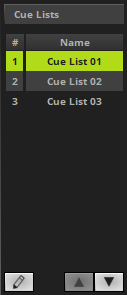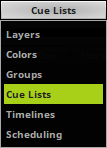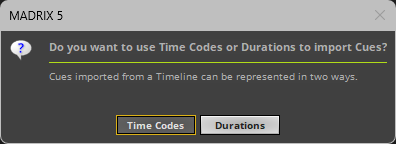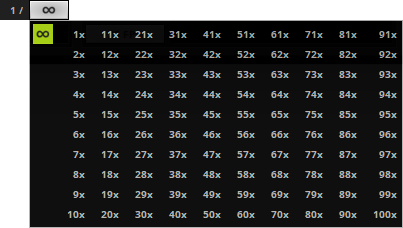This topic includes:
▪File Watcher [Automatic Cue List Reloading]
A Cue List is an automated playlist.
It offers the possibility to precisely manage the automatic playback of effects. Once a Cue List is started, MADRIX 5 will automatically play back your visuals according to your settings and schedule. That means MADRIX 5 switches from Storage Place to Storage Place [i.e. from effect to effect].
The main user interface of MADRIX 5 offers three control buttons for a Cue List.

|
Go - Skips to the next Cue. |
|
Back - Returns to the previous Cue. |
|
Play/Pause - Starts or holds playback of the currently selected Cue List. |
|
Progress - Shows you the relative time progression of the current cue in a progress bar. |
|
Layers > Cue Lists - Opens the window of the Cue List Editor. Use it to set up your Cue Lists. |
You can open the Cue List Editor in 3 ways:
▪Go to the menu Tools > Cue Lists...
▪Or press F7
▪Or click Layers > Cue Lists on the user interface.
To close the Cue List again and change back to the original MADRIX 5 user interface:
▪Go to the menu Tools > Cue Lists...
▪Or press F7
▪Or click Cue Lists > Layers on the user interface.


|
Undock - Creates a separate window to freely use the Editor window detached from the main user interface. |
|
Dock - Brings the separate, detached window back again into the main user interface. |
It is highly recommended to set up your Storage Places [incl. MADRIX Effects, Layers, Chasers, etc.] before using the Cue Lists feature.
Cue Lists
The Cue List Editor is empty when opening it for the first time.
▪You need to create a new Cue List first.
[Navigate the left side of the window.]

|
Add - Creates a new Cue List. ▪You can add more than one Cue List. Remove - Removes the currently selected Cue List. Duplicate - Copies the currently selected Cue List and adds it as a new item. |
|
Position Up - Changes the order, and moves the currently selected Cue List one item higher up in the list. |
|
Position Down- Changes the order, and moves the currently selected Cue List one item lower down in the list. |
#
|
Index - References the different Cue Lists with a continuous index number. Left Mouse Double-Click - Allows you to edit the index. Enter a number and confirm with Enter on your keyboard to change the order of Cue Lists. |
Name |
Shows the label of the Cue List. The software names new Cue Lists Cue List by default. Left Mouse Double-Click - Allows you to edit the name. Enter any name and confirm with Enter on your keyboard. |
▪Note: Only one Cue List can be selected and active at once.
File
Overview
After creating a Cue List, the following file management options become available:
[Navigate to the right side of the window.]
|
Left Mouse Click - Opens the context menu. Open... - Loads a previously saved Cue List file [of the file type *.mclx or *.csv], or Timeline file [of the file type *.mtlx]. Choose the file from your system. Learn more below. Save As... - Stores your Cue List in an external file. You can choose to save in standard *.mclx file format; or to save in *.csv file format in order to easily edit the file with a text editor, for example. Generate Cues From Markers... - See below. Append Cues From Markers... - See below.
Clear - Clears the current Cue List and removes all cues and associated settings. |
|
When importing a Timeline into the Cue List Editor [by opening the Timeline file in the Cue List Editor under File > Open/Open+; as explained above], you can choose how cues are created: Time Codes - Imports from the Timeline and creates cues by using the included time codes. Durations - Imports from the Timeline and creates cues by calculating the durations for each cue based on the time codes of the Timeline. |
Generating Cues From External Markers
In order to exchange timestamps between software applications and equipment, use the File menu to export cues to Markers or generate cues from Markers.
This workflow was mainly implemented to be able to import from the audio-production software REAPER.
|
Left Mouse Click - Opens the context menu. Export Cues As Markers... - Saves configured Cues as an external file in a general file format for exchange between software applications [of the file type *.csv]. Choose the location on your system where to save. Generate Cues From Markers... - Loads Markers from an external file [of the file type *.csv] and creates cues from them. Attention: Any existing cues will be removed in the process. Append Cues From Markers... - Loads Markers from an external file [of the file type *.csv] and adds them as cues to the current Cue List by attaching them to the end [of the file type *.mtlx]. |
|
File Format: MADRIX 5 supports a very general file format for this purpose. CSV files are usually text files with tabularly structured data. #,Name,Start M1,,00:00:02:26 M2,,00:00:06:12 M3,,00:00:11:15
Attention: You need to meet the following prerequisites to be able to import from REAPER! - The supported time format of MADRIX 5 is Hours:Minutes:Seconds:Frames [HH:MM:SS:FF]. - Regions are exported from REAPER and can be included in the export but will simply be ignored by the import process. |
|
Add - Adds a new cue to the Cue List. Right Mouse Click > Cue All - Adds new Cue-List entries for all Storage Places that have a MADRIX 5 Effect customized and stored. # 3 - Displays the total number of cues in the Cue List. |
|
Swap Position - Swaps the position of cues in the list when several cues are selected first. |
1] Add new cues to the Cue List by using
A] Cue on the user interface,
B] + in the Cue List window, or
C] Cue All in the Cue List window.
2] Change each cue as explained in the list below.
- You can even edit the Cue List while it is playing.
- Make sure to change the settings for each cue according to your requirements!
|
Double-Click / Right Mouse Click - Perform a double-click or right click with the mouse onto an entry into the specific column and you will be able to enter and change the values. Multiple Selection - The list allows you to select and modify more than one entry at a time. Select several entries by using Shift + Left Mouse or Ctrl + Left Mouse or Shift + Arrow Keys. Then, right click into the column you want to change. Spacebar or value of -1 - Removes all values or restores the default values. |
|
Double-Click - Perform a double-click on the very first column of the Cue List in order to start playing from this cue [thus performing a Goto]. Make sure to only double-click in the first column. You can even jump to specific cues during Cue List playback in this way. |
|
▪The first column shows the current playback state [Playing, Pause] and can also be used to perform a Goto with the mouse. Perform a double-click on the column in order to start playing from this cue. You can even jump to specific cues during Cue List playback in this way. |
# |
▪MADRIX 5 automatically numbers each cue consecutively with an index number, beginning with 1. |
Description |
▪Automatically fills in a label. This label is based on the Description field of the Storage Place on the user interface. You can change the label if you wish. |
Date |
▪Defines if the entry will be played at a specific date. You can enter 3 different types: ▪Daily - ▪A weekday - ▪A specific date - |
Time Code |
▪Defines a specific time the cue should be played. Use the hours:minutes:seconds:frames format to enter the time: HH:MM:SS:FF ▪You need to confirm new values via Enter Example ▪Offset ▪Automatic Completion |
Duration |
▪Defines how long an effect is going to be played. The Fade Time is calculated as part of the Duration [and is thus a fade in]. ▪Leave the Duration empty if the effect should be active as long as you do not control the Cue List manually [via Go, Back, Play/Pause, or Goto]. ▪Use the hours:minutes:seconds:frames format to enter the time: HH:MM:SS:FF as explained under Time Code ▪You need to confirm new values via Enter |
Follow Cue |
▪You can assign a certain cue to be played after another. As such, a Follow cue assigns the next cue the Cue List should play right after this cue. Follow cues allow you to define a certain order in which cues should be played by the Cue List. Simply enter the number of the cue that should follow. Leave empty if not required. |
Storage |
▪Defines in which Storage the effect is located. Enter a number between 1 and 256 |
Place |
▪Defines the exact Storage Place, where the effect is located. Enter a number between 1 and 256 |
Fade |
▪Defines the Fade Type for the crossfader when the Cue List automatically fades from one effect to another. All Fade Types of the crossfader are available here. Learn more »Crossfader |
Fade Time |
▪Defines the length of the automatic fade for the crossfader and thus creates a fade in. Enter a value in seconds:milliseconds format: SS:MM. Learn more »Crossfader |
Group Preset |
▪Defines which Group Preset is triggered together with this cue. [The Fade Time of the Cue List will automatically be used as the Fade-In Time of the Group Control.] Enter a number between 1 and 256. Leave empty if not required. Learn more »Fixture Groups [Group Control] |

|
Play/Pause - Starts or holds playback of the currently selected Cue List. |
|
Stop - Cancels playback of the currently selected Cue List. When starting playback again, it will start with the next cue. |
|
Back - Returns to the previous cue. |
|
Go - Skips to the next cue. |
|
Loop Mode - All cues will be played back in their respective order [from top to down]. Shuffle Mode - All cues will be played back in one of the following ways: ▪All cues have a Duration, but no Time Code or Follow Cue: Cues will be played back without a specific order. Once all cues have been played, the order will be shuffled again. [All cues will be played the same number of times and the same cue will not be shown twice in succession.] ▪There is at least one cue with a Time Code or Follow Cue: There is no more guarantee that all cues will be played the same number of times. |
|
Loop Count - Defines how often the Cue List is being played back. Once the specified loop count has been reached, the Cue List stops its playback. - Choose from 1x to 100x, or endlessly [which is the default setting]. |
|
Progress - Shows you the relative time progression of the current cue in a progress bar. |
Overview

Time Code is a useful option to trigger effects at certain times of the day or at certain points in time. For example, you might want to trigger Storage Place S1 P1 at 10:00 a.m. or when 3 minutes have passed after the start. Time Code is a convenient way to synchronize independent equipment of your LED installation with each other. This could be external audio equipment, other MADRIX 5 computers, or even the same computer. You might want to set up a time-controlled show in sync with timelines of lighting effects of MADRIX 5 and sound.
Settings
|
▪Time Code Source - Select from which source Time Code should be received. |
|
▪Time Code Format - Allows you choose between different Time Code formats. When receiving Time Code from an external source, use the format sent by the external source. You can choose from: |
00:00:00:00 |
▪Displays the currently used Time Code. The hours:minutes:seconds:frames format is used: HH:MM:SS:FF |
Learn more »Time Code [MIDI / Art-Net / SMPTE / System Time]
▪Do not forget to save your Cue Lists or the complete MADRIX 5 Setup file.
▪When you are using Date, Time Code, and/or Duration, logical routines are implemented to determine which cue should be currently active. These routines are explained in more detail below.

If you are setting up a Date for a cue, 3 options are available to you:
▪Daily,
▪A specific weekday,
▪Or an explicit date.
If you are using a mixture of those three options, a cue will be favored and activated according to the following hierarchy if applicable:
An explicit date overrides a weekday entry. And a weekday entry overrides a daily entry.
For example, daily will activate a cue every single day. But on Mondays, another cue should be activated and it will be. But 2010/04/19 is also a Monday and this cue will be activated this day instead of the daily cue and instead of the Monday cue.
Time Code Without Duration
▪If you are using the column Time Code without the column Duration, a cue will only be activated if the Time Code passes this predefined time.
▪If the Time Code of a cue [without Duration] has already passed that deadline, the cue will not be activated.
Time Code With Duration
A] If you are using the column Time Code and the column Duration, a cue will be activated when the current Time Code falls into this time window.
▪A cue using Time Code and Duration will be activated if it falls into the time window.
▪In addition, the logical routine will check if the Date needs to be considered according to the information above [Date].
For example, if your daily cue should start at 8 o'clock for 8 hours and the current Time Code says 10 o'clock, the cue will be activated.
B] When using Time Code and Duration, you should be aware of what should happen when the Duration is over. A cue with a Time Code and Duration will expire eventually.
▪When a cue with Time Code and Duration is over or has expired, MADRIX 5 will automatically select the next cue; regardless of what the next cue is.
▪MADRIX 5 will not check if the next cue is valid or logic. If you do not want MADRIX 5 to select the next cue, use Follow cues for example or make sure the next cue is set up correctly!
|
Starts or stops the Cue List Recording. See »Recording |
You can choose how MADRIX 5 manages the user interface when playing back a Cue List.
Learn more »User Interface
The majority of controls in MADRIX 5 is disabled while a Cue List is running. The following control controls are available to you even during Cue List playback:
▪Cue List and Cue List controls
▪Submaster Deck A / Deck B
▪Color Filter Deck A / Deck B
▪Filter Deck A / Deck B
▪Speed Masters Deck A / Deck B, including Pause
Learn more »Controls [Deck A / Deck B]
▪Crossfader
▪Main Output Color Filter
▪Main Output Filter
▪Main Output Strobe
Learn more »Crossfader
▪Master, including Freeze and Blackout
▪Audio Output Level, including Mute
▪Audio Input Level, including AGC and Mute
Learn more »Main Output / Master / Audio Levels
▪Group Control
Learn more »Fixture Groups [Group Control]
File Watcher [Automatic Cue List Reloading]
MADRIX 5 can automatically reload a Cue List within a predefined refresh time.
Learn more »General
| MADRIX 5.7. |
| [Ctrl & +/-] = Zoom In/Out | [Ctrl & 0] = 100% |
|
Previous Next
|
|
Enable Automatic Translation | Activer La Traduction Automatique | 启用自动翻译 |




























